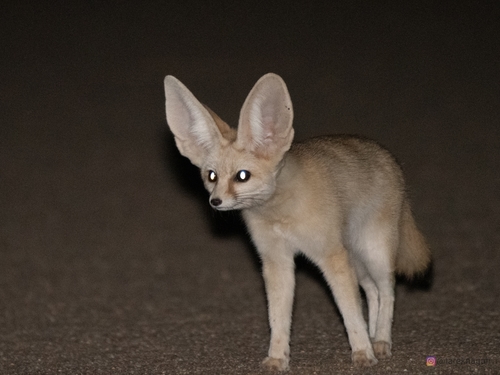
Fennec Fox
The fennec fox, Vulpes zerda, dazzles with oversized ears and a sandy coat, perfectly adapted to the Sahara's harsh climate. This nocturnal marvel thrives in the desert, using acute hearing to hunt. Its role as both predator and prey highlights its ecological importance.
10-14 years
Lifespan
1.0 kg
Weight
Length: 24 - 41 cm
Size
White, Cream, Sandy
Color
9 months
Age of Sexual Maturity
5 weeks
Age of Weaning
25 mph
Top Speed
Least Concern
Conservation Status
Stable
Population Trend
Characteristics
Vulpes zerda, commonly known as the fennec fox, is the smallest fox species, native to the Sahara Desert. It is characterized by its large ears, which help dissipate heat and enhance hearing. The fennec fox is nocturnal, primarily feeding on insects, small mammals, and plants. It has a thick, sandy coat for temperature regulation and camouflage.
Distribution Range of the Fennec Fox
The Fennec Fox (Vulpes zerda) is native to the Sahara Desert and surrounding regions, including North Africa, from Morocco and Mauritania in the west to northern Sudan and Egypt in the east. They are also found in parts of the Sinai Peninsula and the Arabian Desert, extending into Kuwait and the Sinai Peninsula.
Fennec Fox's Habitat
Environmental Conditions
Fennec Foxes inhabit arid desert environments characterized by extreme temperatures, ranging from very hot days to cooler nights. They thrive in sandy and semi-arid regions where they can dig burrows for shelter and protection from the harsh climate.
Ecological Niche
The Fennec Fox is adapted to its desert habitat with features like large ears for dissipating heat and keen hearing to detect prey. They are nocturnal, which helps them avoid daytime heat, and they have a diet that includes insects, small mammals, birds, and plants, allowing them to exploit a variety of food sources in their environment. Their ability to survive with minimal water intake by obtaining moisture from their prey is a key adaptation to their ecological niche.
Copyright @ Nature Style Limited. All Rights Reserved.
 English
English